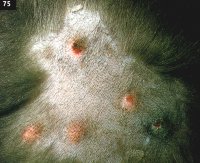
|
PA NNICULITISNote for Pet Owners: This information is provided by Provet for educational purposes only. You should seek the advice of your veterinarian if your pet is ill as only he or she can correctly advise on the diagnosis and recommend the treatment that is most appropriate for your pet. Topics on this Page: |
Description
Panniculitis is inflammation of fat under the skin. It results in small inflamed
nodules appearing on the surface of the skin.

This photograph has been reproduced from "Skin diseases of the Dog and Cat" by Harvey and McKeever with the kind permission of Manson Publishing
Cause
There are many possible causes including :
- Post-injection
- Trauma
- Local impairment of blood supply (ischaemia)
- Immune disorders
- Bacterial or fungal infections - may be secondary invaders
- Feline pansteatitis (due to excessive dietary unsaturated fatty acid intake, and/or vitamin E deficiency)
- Idiopathic - sterile panniculitis
Breed Occurrence
Dachshunds are more often affected than other breeds. Sterile pedal panniculitis
is reported to occur in German Shepherd Dogs. There is no age or sex
predisposition.
Signs
Cats with pansteatitis have other systemic signs including acute abdominal pain, high body temperature and anorexia.
Complications
Diagnosis
Excision biopsy for solitary lesions with histopathological examination,
microbiological culture and sensitivity testing.
Treatment
Surgical removal of solitary nodules. Antibiotic or antifungal medication as
appropriate.
Dietary management for cats with pansteatitis involves reducing fat intake and vitamin E supplementation.
In some cases of recurrence corticosteroids have been reported to have been used successfully, but long term treatment should be avoided if possible.
Prognosis
Most animals will recover uneventfully if the underlying cause is corrected.
Long term problems
Updated October 2013
d>